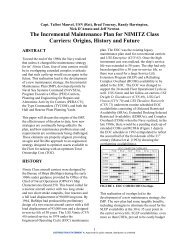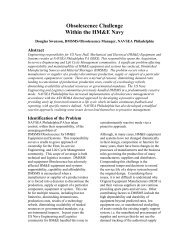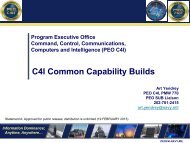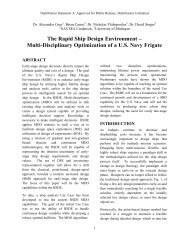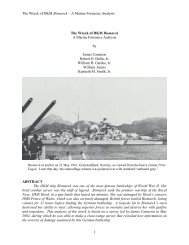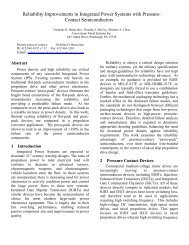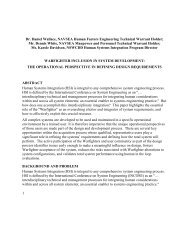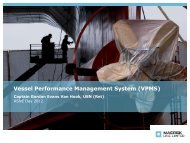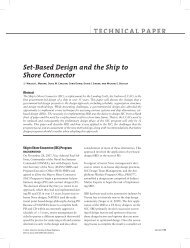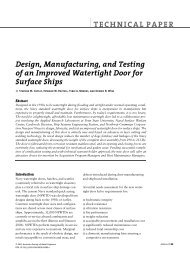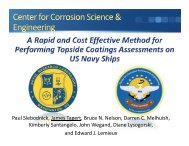Rebuilding the NAVSEA Early Stage Ship Design Environment - ASNE
Rebuilding the NAVSEA Early Stage Ship Design Environment - ASNE
Rebuilding the NAVSEA Early Stage Ship Design Environment - ASNE
You also want an ePaper? Increase the reach of your titles
YUMPU automatically turns print PDFs into web optimized ePapers that Google loves.
<strong>Rebuilding</strong> <strong>the</strong> <strong>NAVSEA</strong> <strong>Early</strong> <strong>Stage</strong> <strong>Ship</strong> <strong>Design</strong> <strong>Environment</strong><br />
Ben Kassel 1 , Seth Cooper 2 , and Adrian Mackenna 1<br />
1 Naval Surface Warfare Center, Carderock Division<br />
2 Naval Sea Systems Command<br />
ABSTRACT<br />
It has been well over a decade since <strong>the</strong> last time <strong>the</strong> Naval Sea Systems Command (<strong>NAVSEA</strong>) performed a full<br />
blown preliminary and contract ship design. During that time period <strong>the</strong>re have been many advances in <strong>the</strong><br />
underlying technology used by design tools, and <strong>the</strong>re have also been changes to <strong>the</strong> design process as well. As a<br />
result, <strong>NAVSEA</strong> has <strong>the</strong> responsibility to evaluate tools and processes in order to develop <strong>the</strong> next generation early<br />
stage ship design environment so that we do not continue to design tomorrow’s ships with yesterday’s tools. This<br />
paper discusses <strong>the</strong> role product model technology, high performance computing, and early stage design tools can<br />
play in <strong>the</strong> development of future naval vessels. The subject of design tools will be explored from <strong>the</strong> perspective of<br />
how <strong>the</strong>y improve <strong>the</strong> early stage ship design process as well as <strong>the</strong>ir role in gaining insights and supporting<br />
oversight during <strong>the</strong> detailed design and construction phases of a ship’s lifecycle.<br />
NOMENCLATURE<br />
CAD - Computer-Aided <strong>Design</strong><br />
CREATE – Computational Research and Engineering<br />
Acquisition Tools and <strong>Environment</strong>s<br />
HPC – High Performance Computers<br />
ONR – Office of Naval Research<br />
FEM – Finite Element Model<br />
FEA – Finite Element Analysis<br />
IGES – Initial Graphics Exchange Specification<br />
NPDI – Navy Product Data Initiative<br />
STEP – Standard for <strong>the</strong> Exchange of Product data<br />
(ISO 10303)<br />
LEAPS – Leading Edge Architecture for Prototyping<br />
Systems<br />
ASSET – Advanced <strong>Ship</strong> and Submarine Evaluation<br />
Tool<br />
COTS – Commercial Off-<strong>the</strong>-Shelf Software<br />
INTRODUCTION<br />
Change is a permanent fixture within <strong>the</strong> US<br />
Naval <strong>Ship</strong>building industry, to <strong>the</strong> acquisition<br />
process, and within <strong>the</strong> <strong>NAVSEA</strong> enterprise. It has<br />
been several years since an early stage design has<br />
been led and completed by <strong>the</strong> government (Keane et<br />
al. 2009). Major changes have occurred in both <strong>the</strong><br />
sophistication of software products available to <strong>the</strong><br />
marine industry as well as <strong>the</strong> available computing<br />
power. Open architectures and <strong>the</strong> availability of<br />
standards for <strong>the</strong> definition of product model data has<br />
<strong>the</strong> potential to improve <strong>the</strong> early stage design<br />
process. Of course, many issues arise when<br />
establishing a design site, but this paper only<br />
examines issues of product model technology,<br />
software, and early stage design tools. But one thing<br />
is for sure, <strong>the</strong> early stage knowledge embedded<br />
within <strong>the</strong> <strong>NAVSEA</strong> enterprise is retiring. The<br />
humans that managed, performed, and supported<br />
early stage ship design are all but gone. If <strong>the</strong> next<br />
generation of early stage ship designers are not<br />
deliberately trained, mentored, and given <strong>the</strong> tools<br />
<strong>the</strong>y need to design 21 st century ships within <strong>the</strong> next<br />
few years, <strong>the</strong>re is a distinct possibility <strong>the</strong>re will be<br />
none of <strong>the</strong> current generation left to pass on <strong>the</strong><br />
trade.<br />
A BRIEF HISTORY<br />
Up through <strong>the</strong> 1990’s design sites supporting <strong>the</strong><br />
early stage design of surface ships and submarines<br />
were commonplace within <strong>NAVSEA</strong> (Ayers et al.<br />
1998). These design sites could be found within<br />
<strong>NAVSEA</strong> office spaces, contractors’ facilities, and at<br />
<strong>the</strong> Naval <strong>Ship</strong> R&D Center in Carderock, MD. They<br />
were staffed by a mixture of <strong>NAVSEA</strong> and Warfare<br />
Center employees and resources obtained from local<br />
Naval Architecture firms. Depending on <strong>the</strong><br />
acquisition strategy, some of <strong>the</strong> design teams would<br />
include <strong>the</strong> shipyards that may be bidding on <strong>the</strong><br />
detailed design and construction. During <strong>the</strong>se<br />
bygone days, <strong>NAVSEA</strong> was deeply involved in <strong>the</strong><br />
use and customization of commercial CAD systems,<br />
<strong>the</strong> continuous evaluation of commercial Naval<br />
Architecture tools, and where necessary, <strong>the</strong><br />
development of specific design tools. <strong>NAVSEA</strong>, as<br />
<strong>ASNE</strong> 2010 Kassel, Cooper, Mackenna 1
well as any major enterprise involved in <strong>the</strong> design of<br />
<strong>the</strong>ir products struggled with <strong>the</strong> balance between <strong>the</strong><br />
use of commercially available software and <strong>the</strong> inhouse<br />
development of software. This problem was<br />
compounded by <strong>the</strong> relatively small size of <strong>the</strong><br />
marine sector coupled with trying to define <strong>the</strong><br />
Navy's core competencies in software development.<br />
During <strong>the</strong> acquisition reform of <strong>the</strong> mid-nineties,<br />
many of <strong>the</strong> responsibilities traditionally assigned to<br />
<strong>the</strong> <strong>NAVSEA</strong> engineering directorate were transferred<br />
to <strong>the</strong> industrial sector. One critical result was less<br />
Navy engineering and more Navy engineering<br />
oversight. The old adage goes "you forget what you<br />
hear, you remember what you see, and you know<br />
what you do." Because <strong>NAVSEA</strong> is not doing ship<br />
design, it is missing an opportunity to pass on<br />
corporate engineering knowledge to <strong>the</strong> next<br />
generation of ship designers, ship design managers,<br />
and design integration managers. The time is ripe for<br />
<strong>NAVSEA</strong> to rebuild its early stage design<br />
competency. With improvements in information<br />
technology, we are afforded an opportunity to<br />
integrate cutting edge information technologies with<br />
established analysis tools and <strong>the</strong> knowledge of an<br />
aging workforce.<br />
THE CASE FOR TOOL DEVELOPMENT<br />
<strong>Ship</strong>s are large and complex products and have a<br />
long development cycle. It is widely recognized<br />
throughout <strong>the</strong> engineering world that decisions made<br />
during <strong>the</strong> conceptual design phase have <strong>the</strong> largest<br />
impacts on cost, performance, and schedule. Many<br />
of <strong>the</strong> critical requirements levied on a warship<br />
require complex analysis to verify that <strong>the</strong>y are met<br />
(such as hull fatigue life, vulnerability/shock<br />
performance, signatures, and topside<br />
sensing/communication performance). These<br />
complex analyses require a high level of design<br />
definition, which is typically not available until <strong>the</strong><br />
detailed design and construction phase. In <strong>the</strong><br />
current design paradigm, analysis results that verify if<br />
a ship design meets its requirements come after <strong>the</strong>ir<br />
opportunity to influence <strong>the</strong> design. Because of <strong>the</strong><br />
limited amount of tool integration, and a manual ship<br />
design definition process, <strong>the</strong> Navy enterprise usually<br />
driven to select one design alternative early in <strong>the</strong><br />
design process. Much of <strong>the</strong> rest of <strong>the</strong> design effort<br />
is spent detailing and reworking this single<br />
alternative to meet <strong>the</strong> requirements and cost goals.<br />
The vision for Navy design tools is to move to a<br />
automated high-end toolset that integrates many<br />
information dense design definition tools with high<br />
fidelity physics-based analysis tools. This toolset<br />
will be able explore many ship design alternatives to<br />
populate a feasible design space. This design space<br />
will be used to perform real time cost-benefit trades<br />
on ship requirements during <strong>the</strong> requirements<br />
definition process. A system such as this could be<br />
used to explore <strong>the</strong> design space to ensure that <strong>the</strong><br />
correct design is selected before signing a contract to<br />
build a ship.<br />
Direction on this was given to <strong>NAVSEA</strong> in<br />
February of 2008 in a memo from Admiral Sullivan,<br />
who was <strong>the</strong>n COM<strong>NAVSEA</strong>, which outlines types<br />
of tools and tool developments needed. The memo<br />
sates that,<br />
Accomplishing <strong>the</strong>se ambitious goals will be a challenge,<br />
but is essential for crafting affordable, executable ship<br />
programs in an increasingly complex national security<br />
environment. Previous Navy design tool investment has<br />
resulted in <strong>the</strong> Advanced <strong>Ship</strong> and Submarine Evaluation<br />
Tool (ASSET) for total ship syn<strong>the</strong>sis, and <strong>the</strong> Leading<br />
Edge Architecture for Prototyping Systems (LEAPS) for<br />
integrating a wide range of analysis tools in a common<br />
data environment. Future tool development should build<br />
upon <strong>the</strong>se foundations, adding capability to meet <strong>the</strong><br />
goals outlined in this memorandum. [Ser 05D/047, 4 Feb<br />
2008]<br />
ASSET is software that has been built and<br />
maintained by <strong>the</strong> Navy at NSWC Carderock for over<br />
25 years, and it is currently <strong>the</strong> principal tool used in<br />
earliest stages of ship design. ASSET is unique in that<br />
it combines ship design disciplines into one<br />
syn<strong>the</strong>sized whole-ship model that represents a<br />
balanced design. A major issue is that ASSET does<br />
not produce <strong>the</strong> level of design definition required for<br />
many of <strong>the</strong> higher-level analyses required in <strong>the</strong> later<br />
stages of ship design. When a design progresses<br />
beyond concept design, where a more detailed<br />
analysis is needed, <strong>the</strong> design integration provided<br />
between disciplines by ASSET is lost. Existing<br />
analysis tools typically require <strong>the</strong>ir own custom<br />
format of input data. Up to 90% of <strong>the</strong> time spent on<br />
<strong>the</strong>se analyses is spent preparing <strong>the</strong> input, which<br />
often means manually recreating design data that was<br />
already created in ano<strong>the</strong>r tool. This data recreation<br />
accounts for most of <strong>the</strong> time, cost, and error<br />
associated with analysis.<br />
<strong>ASNE</strong> 2010 Kassel, Cooper, Mackenna 2
The effort to solve this time-delay and<br />
configuration control issue between high-end tools is<br />
LEAPS. LEAPS is also developed and maintained by<br />
<strong>the</strong> Navy at NSWC Carderock, and has been a 15-<br />
year effort. At its base LEAPS is a digital<br />
representation of <strong>the</strong> ship designed to be expansible<br />
to include all information necessary to perform any<br />
relevant analysis and store <strong>the</strong> results of those<br />
analyses for use by o<strong>the</strong>r analyses. It is <strong>the</strong> hub,<br />
while detailed discipline-specific tools represent <strong>the</strong><br />
spokes in a ship design cycle. Careful though and<br />
planning is required to bring a LEAPS based design<br />
and analysis for a new ship to fruition. What design<br />
and analysis activities are performed at each phase of<br />
<strong>the</strong> design should be planned carefully to ensure that<br />
<strong>the</strong> information is created before it is required. The<br />
way that design tools interact is directly related to <strong>the</strong><br />
way we design ships, and <strong>the</strong> way people think about<br />
design. The process that forms <strong>the</strong> foundation of<br />
ASSET reflects <strong>the</strong> roles and responsibilities of<br />
<strong>NAVSEA</strong> at <strong>the</strong> time ASSET was created. Efforts are<br />
currently underway to map <strong>the</strong> entire ship design<br />
process so that gaps in <strong>the</strong> ship design toolset can be<br />
identified. This map will also allow <strong>NAVSEA</strong> to<br />
engineer and streamline <strong>the</strong> ship design process. This<br />
effort is tied to <strong>the</strong> <strong>NAVSEA</strong> Tools Roadmap<br />
development and semi-annual workshops sponsored<br />
by <strong>NAVSEA</strong>, ONR, and <strong>the</strong> CREATE program, but<br />
this is a subject for ano<strong>the</strong>r paper.<br />
CREATE (Computational Research and<br />
Engineering Acquisition Tools and <strong>Environment</strong>s) is<br />
a DoD program that is focused on tackling many of<br />
<strong>the</strong>se challenges. The program is run out of <strong>the</strong> DoD<br />
High Performance Computers Modernization Office<br />
(HPCMO). CREATE-SHIPS (a portion of <strong>the</strong> overall<br />
CREATE program) is budgeted to spend several<br />
million dollars from HPCMO over <strong>the</strong> next few<br />
years, and focuses on leveraging <strong>the</strong> modern<br />
increases in computational power to develop <strong>the</strong><br />
high-end toolset and enable this process of rapidly<br />
designing and analyzing large number if ship designs.<br />
CREATE-SHIPS is a partnership between <strong>NAVSEA</strong>,<br />
ONR, HPCMO, and PEO SHIPS. Ano<strong>the</strong>r positive<br />
step at <strong>NAVSEA</strong> was <strong>the</strong> establishment of <strong>the</strong><br />
Technical Warrant Holder position for <strong>Ship</strong> <strong>Design</strong><br />
Tools in October of 2008 as a step towards raising <strong>the</strong><br />
importance of ship design tools in <strong>the</strong> overall design<br />
and certification process. In December 2009, this<br />
position was moved to <strong>the</strong> <strong>NAVSEA</strong> 05 Chief<br />
Technology Office as <strong>the</strong> Tools Program Manager,<br />
fur<strong>the</strong>r elevating <strong>the</strong> importance of tool development<br />
to <strong>the</strong> NAVEA enterprise.<br />
In addition to <strong>the</strong> issue of configuration between<br />
disciplines, many aspects of ship design do not have<br />
sufficient tools and models in existence, and<br />
increasingly rely on engineering judgment and large<br />
factors of safety. For instance, we are often looking at<br />
new and innovative ways to estimate a ship’s<br />
manning requirements or costs at an early stage. But<br />
developing and improving <strong>the</strong> individual high-end<br />
tools <strong>the</strong>mselves is not as simple as implementing a<br />
<strong>the</strong>ory into a computer algorithm. Tools need to be<br />
verified and validated; problems must be easy to set<br />
up and run; geometry and mesh generation must be<br />
easy and quick; tools must be built to run effectively<br />
and efficiently on highly complex massively parallel<br />
computers; and, results must be timely. Many of <strong>the</strong><br />
tools we use are highly specialized, and not used<br />
beyond <strong>the</strong> narrow realm of Naval ship design. The<br />
results of <strong>the</strong>se complex analyses must be visualized<br />
and packaged in a way that <strong>the</strong>y are easy to<br />
understand by both <strong>the</strong> design engineers and program<br />
managers such that <strong>the</strong>y can be <strong>the</strong> basis of a smart,<br />
timely decision making process.<br />
A CREATE effort of note is <strong>the</strong> development of<br />
<strong>the</strong> Integrated Hydrodynamics <strong>Design</strong> <strong>Environment</strong><br />
(IHDE). For ship hydrodynamics a large set of<br />
specialized commercial, government, and even<br />
university built research tools and models is used for<br />
all aspects of ship hydrodynamics such as resistance,<br />
seakeeping, stability, and fluid-structure interactions.<br />
Most of <strong>the</strong>se tools are highly specialized and only<br />
experts can run <strong>the</strong>m. The IHDE, now in its second<br />
year of development, seeks to provide a unified easyto-use<br />
system that gives a ship designer <strong>the</strong> ability to<br />
interface more directly with <strong>the</strong>se tools. It also has<br />
<strong>the</strong> ability to create input files from ship design data<br />
available in <strong>the</strong> LEAPS representation of <strong>the</strong> ship<br />
Figure 1 The Integrated Hullform <strong>Design</strong> <strong>Environment</strong> ties toge<strong>the</strong>r<br />
several hydrodynamics tools<br />
automatically, and to store <strong>the</strong> results of <strong>the</strong> analysis<br />
back into LEAPS.<br />
Ano<strong>the</strong>r software development worthy of<br />
discussion here is Intelligent <strong>Ship</strong> Arrangements<br />
(ISA), which is a tool in its infant stages developed as<br />
<strong>ASNE</strong> 2010 Kassel, Cooper, Mackenna 3
a research project at <strong>the</strong> University of Michigan and<br />
not yet transitioned to Navy use. As mentioned<br />
earlier, many cases an analysis cannot be performed<br />
due to a lack of <strong>the</strong> design definition needed. A major<br />
hurdle is that ship arrangements—<strong>the</strong> way that<br />
compartments and machinery are laid out relative to<br />
one ano<strong>the</strong>r—is an intensive manual process and<br />
often considered more art than science because of <strong>the</strong><br />
unlimited number of viable solutions. This tool looks<br />
at <strong>the</strong> arrangements within a ship's hull as an<br />
industrial engineering problem, a hybrid of efficiently<br />
packing a box and laying out circuitry on a<br />
microchip, and arranges <strong>the</strong> ship according to<br />
constraints and rules set by <strong>the</strong> users ahead of time.<br />
When used in a systematic and stochastic way, and<br />
when integrated using LEAPS, having this type of<br />
design information early in <strong>the</strong> design process can<br />
feed into analyses such as manning, vulnerability,<br />
producibility, and a number of o<strong>the</strong>r “ilities” in time<br />
to influence major ship design decisions.<br />
Ultimately, our goal is to shrink <strong>the</strong> time required<br />
to generate a sufficient amount of information to<br />
make informed design decisions early in <strong>the</strong> ship<br />
design process before <strong>the</strong> requirements are set and<br />
cost of <strong>the</strong> ship is locked in. By considering an<br />
integrated computational ship model as a “virtual<br />
prototype,” several design iterations are possible in a<br />
far shorter amount of time than a single design-buildtest<br />
cycle of a traditional prototype.<br />
One commercial example illustrates what we can<br />
now achieve with this paradigm. In <strong>the</strong> early 1990s,<br />
Goodyear Tire faced intense international<br />
competition. Its rivals had more engineering design<br />
resources, testing capacity, and lower production<br />
costs—Goodyear was rapidly falling behind. To<br />
respond and develop a competitive advantage, it<br />
replaced <strong>the</strong> traditional engineering process (design,<br />
build, test, and repeat) that had served it well for<br />
more than 100 years with physics-based<br />
computational engineering tools to design, mesh, and<br />
analyze new products. Engineers built and tested just<br />
<strong>the</strong> final, optimized designs, <strong>the</strong>reby reducing<br />
Goodyear’s time to market from three years to less<br />
than a year. The company started producing several<br />
new designs a year instead of one or two every few<br />
years. Goodyear is now <strong>the</strong> largest US tire<br />
manufacturer and is competitive in <strong>the</strong> world market.<br />
Whirlpool, Proctor and Gamble, Boeing, Ping Golf,<br />
and Pratt and Whitney, to name a few, have also<br />
adopted this new paradigm with similar success.<br />
In addition, Systems Engineering tools and<br />
methodologies such as Set-Based <strong>Design</strong> along with<br />
techniques for <strong>Design</strong> of Experiments and Multi-<br />
Disciplinary Optimization can help integrate<br />
seemingly disparate types of analysis. Stochastic<br />
analysis, now available to us through automation and<br />
high-speed computing, will not only allow us to<br />
better capture uncertainty into <strong>the</strong> design process, but<br />
it allows several single aspects of a ship design to be<br />
explored comprehensively on <strong>the</strong>ir own before<br />
comparing <strong>the</strong>m to ensure convergence and<br />
feasibility of <strong>the</strong> ship design as a whole. In addition<br />
to linking ship structures, hydrodynamics, and<br />
susceptibility models for instance, <strong>the</strong> front end can<br />
link to force models and <strong>the</strong> back end can link with<br />
cost and affordability models to provide a full picture<br />
to decision makers so that timely decisions can be<br />
made with confidence.<br />
AN INTRODUCTION TO EARLY STAGE SHIP<br />
DESIGN<br />
Decisions made early on in <strong>the</strong> ship design process<br />
have large impacts on ship functionality that isn’t<br />
quantified until <strong>the</strong> design is mature. Often <strong>the</strong>se<br />
impacts are only vaguely understood at <strong>the</strong> outset of<br />
<strong>the</strong> design cycle, and by <strong>the</strong> time that <strong>the</strong> impacts are<br />
fully understood it is too late to make significant<br />
changes. An example of this could be <strong>the</strong><br />
vulnerability of <strong>the</strong> ship: in order to asses a ship’s<br />
vulnerability, a detailed layout of compartments and<br />
distributed systems is needed, but early on in <strong>the</strong> ship<br />
design, when sizing decisions are made, detailed<br />
layouts are not available and a ship designer has little<br />
more than rules-of-thumb to base <strong>the</strong>se crucial<br />
decisions upon. With High Performance Computing<br />
(HPC) as an enabler, <strong>the</strong> vision is to explore all<br />
downstream implications of decisions made during<br />
<strong>the</strong> initial concept development and apply that<br />
knowledge as early on in <strong>the</strong> design process as<br />
possible. In <strong>the</strong> vulnerability example used above, for<br />
instance, an automated tool (such as ISA mentioned<br />
earlier) could rapidly produce a full range of feasible<br />
ship arrangements from a basic shell of a ship, and<br />
<strong>the</strong>n a vulnerability assessment could be performed<br />
on each of <strong>the</strong>se many design variations and <strong>the</strong><br />
resultant range of achievable levels of vulnerability<br />
<strong>ASNE</strong> 2010 Kassel, Cooper, Mackenna 4
can be fed back to <strong>the</strong> designer—with all of <strong>the</strong> highspeed<br />
computation happening behind <strong>the</strong> scenes.<br />
Thus, <strong>the</strong> designer is instantly aware of <strong>the</strong><br />
vulnerability implications of <strong>the</strong> sizing and<br />
arrangement of <strong>the</strong> ship.<br />
<strong>Design</strong> Spiral versus Set-Based <strong>Design</strong><br />
Naval <strong>Ship</strong> <strong>Design</strong> involves complex interactions<br />
between many disciplines, and reconciling <strong>the</strong> needs<br />
of one system against o<strong>the</strong>rs becomes a delicate<br />
balancing act. The convergence of various disciplinespecific<br />
ship models into a single coherent design is a<br />
process that <strong>NAVSEA</strong> has termed “<strong>Ship</strong> Syn<strong>the</strong>sis,”<br />
and is currently chiefly performed using <strong>the</strong> Navy’s<br />
in-house tool ASSET. ASSET is made up of<br />
discipline specific modules (i.e. hull geometry, gross<br />
arrangement, hull structural design, resistance and<br />
propulsion, power plant sizing, weight estimation,<br />
and area/volume sufficiency analysis). ASSET<br />
performs syn<strong>the</strong>sis between <strong>the</strong>se modules using a<br />
design spiral approach. This means that disciplines<br />
are analyzed one at a time before moving to <strong>the</strong> next<br />
one, and multiple iterations are performed through<br />
<strong>the</strong> spiral process in order to converge into a single<br />
solution. Each loop is a serial process that must be<br />
done in order, and control of each design variable<br />
must be carefully managed. The modules in ASSET<br />
are highly coupled so that <strong>the</strong> dynamic process of<br />
syn<strong>the</strong>sis is stable and converges on a solution.<br />
In a Set-Based <strong>Design</strong> approach, which has been<br />
identified as a preferred approach for <strong>the</strong><br />
development of future U.S. Naval design efforts,<br />
discipline-specific designs are done in parallel across<br />
a broad design space. This process is designed to<br />
improve <strong>the</strong> flexibility of <strong>the</strong> design by delaying key<br />
decisions until <strong>the</strong> design space is fully understood,<br />
but <strong>the</strong> parallel nature of <strong>the</strong> approach also makes it<br />
an ideal fit for HPC application. Currently, set-based<br />
design, as practiced in <strong>the</strong> Navy’s <strong>Ship</strong>-to-Shore<br />
Connector program, relies on engineering interaction<br />
and judgment for creating <strong>the</strong> set information from<br />
each discipline and integrating <strong>the</strong> results from<br />
multiple disciplines in order to find a set of possible<br />
solutions. But techniques known as Multi-<br />
Disciplinary Optimization (MDO) offer <strong>the</strong><br />
infrastructure for integrating <strong>the</strong> set based design<br />
<strong>the</strong>ory into Navy ship design tools in a<br />
ma<strong>the</strong>matically rigorous and automated manner.<br />
Applications of MDO techniques to ship syn<strong>the</strong>sis<br />
are ready to be tested and implemented and are<br />
moving forward. Due to <strong>the</strong> highly coupled,<br />
multivariate nature of <strong>the</strong> ship design problem, MDO<br />
will be challenging, but holds great promise as an<br />
integrating agent.<br />
The Navy Business Model<br />
It is important at this point in <strong>the</strong> discussion to<br />
recognize <strong>the</strong> business environment in which <strong>the</strong><br />
Navy designs ships. Although <strong>the</strong> details of ship<br />
procurement seem to change weekly, <strong>the</strong> basic initial<br />
design process remains generally <strong>the</strong> same. In <strong>the</strong><br />
initial phase a large design space of many options is<br />
explored to a low level of fidelity, and with each<br />
successive phase of <strong>the</strong> design, guidance is given to<br />
<strong>the</strong> designer by a decision maker and <strong>the</strong> fidelity of<br />
<strong>the</strong> design is increased along with a decrease in <strong>the</strong><br />
range of options available. This process is depicted<br />
graphically in Figure 2. As <strong>the</strong> design space starts to<br />
become defined, higher order models can be<br />
Phase 1<br />
DESIGN SPACE<br />
Phase 2<br />
Phase 3<br />
Figure 2 As <strong>the</strong> fidelity of <strong>the</strong> design increases, <strong>the</strong> design space<br />
under consideration gets smaller.<br />
substituted into <strong>the</strong> <strong>Ship</strong> Syn<strong>the</strong>sis process. HPC<br />
tools, such as <strong>the</strong> ones being developed under <strong>the</strong><br />
CREATE Hydro and Shock projects, can become<br />
appropriate higher order models when <strong>the</strong> design<br />
space becomes sufficiently defined, and as <strong>the</strong>se tools<br />
become faster and more accessible, <strong>the</strong>y can be used<br />
in earlier phases of <strong>the</strong> design.<br />
HPC tools for o<strong>the</strong>r disciplines, beyond just<br />
hydrodynamics and shock, need development as well,<br />
and an analysis of which disciplines hold promising<br />
<strong>the</strong>ories that are applicable to solution by HPC (i.e.<br />
<strong>ASNE</strong> 2010 Kassel, Cooper, Mackenna 5
large amounts of numerical calculations) should be<br />
done, and investments should be made in those areas.<br />
An example of this is <strong>the</strong> Intelligent <strong>Ship</strong><br />
Arrangement technique under development at <strong>the</strong><br />
University of Michigan, which was mentioned earlier<br />
in <strong>the</strong> paper.<br />
ASSET Evolution<br />
The vision for future ASSET is to expand its ship<br />
definition and analysis capability. <strong>Ship</strong> definition<br />
capability will be greatly enhanced through <strong>the</strong> use of<br />
a 3D NURBS based geometry<br />
definition/manipulation, arrangements, and<br />
component placement capability. This capabiltiy will<br />
come through <strong>the</strong> conversion of <strong>the</strong> ASSET data<br />
model into a LEAPS data model. This will allow <strong>the</strong><br />
rapid turnaround between this design tool and higher<br />
fidelity physics models that require complicated<br />
mesh-able geometry and detailed ship design<br />
information. Arrangement details such as topside<br />
design and distributed system routing/architecture<br />
will make it possible to assess topside effectiveness<br />
and vulnerability during concept design. Pre-defined<br />
components will be stored in a LEAPS database and<br />
used in <strong>the</strong> ASSET model. ASSET will be run in a<br />
batch mode to create hundreds or thousands of<br />
feasible design variants that will be analyzed to<br />
determine <strong>the</strong>ir effectiveness.<br />
Using Behavior Models<br />
In order to use higher order models within a <strong>Ship</strong><br />
Syn<strong>the</strong>sis process and get results in a timely manner,<br />
<strong>the</strong> results of many runs of <strong>the</strong> higher order models<br />
must be abstracted into a “Behavior Model.” These<br />
are sometimes also referred to as “Surrogate<br />
Models,” or “Response Surfaces.” The idea behind a<br />
Behavior Model is that from many discrete points in<br />
a design space, a continuous function can be closely<br />
fit, and that function can be queried instantaneously<br />
ra<strong>the</strong>r than re-running <strong>the</strong> computationally intensive<br />
higher order model. In this way, <strong>the</strong> <strong>Ship</strong> Syn<strong>the</strong>sis<br />
process using full physics models can be done in real<br />
time. The design space can be explored or an<br />
optimization performed in a reasonable timeframe by<br />
a single user. Done in this manner, several higher<br />
order models in several disciplines can be run in a<br />
highly parallel way over a broad range of design<br />
space prior to <strong>the</strong> <strong>Ship</strong> Syn<strong>the</strong>sis process. Figure 2<br />
illustrates <strong>the</strong> process of defining a feasible design<br />
space in an initial phase of <strong>the</strong> design. Later an aspect<br />
of <strong>the</strong> design is explored in more detail using HPC<br />
tools, and a Behavior Model is developed from <strong>the</strong><br />
results. This Behavior model can <strong>the</strong>n be<br />
incorporated back into a <strong>Ship</strong> Syn<strong>the</strong>sis in <strong>the</strong> next<br />
design phase. A similar approach to this was taken<br />
during <strong>the</strong> ONR HSSL effort, where seakeeping and<br />
resistance Behavior Models were developed based on<br />
parametric hullform changes, and <strong>the</strong>se Behavior<br />
Models were used as part of <strong>Ship</strong> Syn<strong>the</strong>sis. Using<br />
HPC, this effort was able to build <strong>the</strong>se Behavior<br />
Models in two to three days ra<strong>the</strong>r than <strong>the</strong> 5,000 plus<br />
hours of computing time that it would have taken<br />
o<strong>the</strong>rwise.<br />
Syn<strong>the</strong>sis Model<br />
<strong>Design</strong><br />
Space<br />
High<br />
Performance<br />
Computing<br />
Develop<br />
Behavior<br />
Model<br />
Figure 3. Higher order models used in successive design<br />
phases in <strong>the</strong> <strong>Ship</strong> Syn<strong>the</strong>sis process can be Behavior<br />
Models created from HPC results.<br />
Several ma<strong>the</strong>matical models exist for developing<br />
Behavior Models, including polynomial splines,<br />
neural networks, and Kriging, and some are more<br />
appropriate than o<strong>the</strong>rs for certain applications. These<br />
methods need to be characterized and developed into<br />
software that works within <strong>the</strong> Navy's ship design<br />
infrastructure and can be used in a parallel computing<br />
environment.<br />
Leading Edge Architecture for Prototyping for<br />
Systems<br />
LEAPS is a Navy developed environment for<br />
storing information about ship designs. It functions as<br />
a database that is capable of storing multiple ship<br />
<strong>ASNE</strong> 2010 Kassel, Cooper, Mackenna 6
concepts, including detailed geometry information,<br />
numerical design information, system attribution, and<br />
behavior objects. A fur<strong>the</strong>r discussion of LEAPS as a<br />
product model is discussed later in this paper.<br />
Currently, CREATE <strong>Ship</strong>s has funded <strong>the</strong><br />
University of Michigan to update <strong>the</strong> database<br />
structure of LEAPS to enable queries to be made in<br />
parallel, enabling <strong>the</strong> use of LEAPS in a highly<br />
parallel computing job such as running many designs<br />
through multiple scenarios in a seakeeping analysis.<br />
The DOD CREATE program, along with<br />
<strong>NAVSEA</strong>, is also currently developing <strong>the</strong> capability<br />
within LEAPS to parametrically distort a parent<br />
hullform so that a large design space can be created<br />
and run through HPC analysis tools such as those<br />
accessible from <strong>the</strong> Integrated Hydrodynamics<br />
<strong>Design</strong> <strong>Environment</strong>. This hullform manipulation<br />
toolkit is also an enabler for doing set-based design<br />
of <strong>the</strong> hullform in parallel with o<strong>the</strong>r aspects of <strong>the</strong><br />
ship.<br />
Planned Tool Improvements for <strong>the</strong> Concept<br />
<strong>Design</strong> Phase<br />
In <strong>the</strong> concept design phase, <strong>the</strong> ship design<br />
organization should explore large sets of potential<br />
design alternatives using design space exploration<br />
and visualization methods. To use this method, an<br />
automated toolset is needed that can rapidly populate<br />
a design space with performance, cost, and risk data.<br />
There are several areas of improvement that have<br />
been identified to fill in a complete toolset for<br />
concept design. As we continue to identify and<br />
prioritize <strong>the</strong>se, actions should be taken to improve<br />
those areas.<br />
During this phase <strong>the</strong> level of detail may be<br />
relatively low, but <strong>the</strong> design is extremely dynamic.<br />
The process is dominated by syn<strong>the</strong>sis tools and low<br />
level analysis. The emphasis during this phase is to<br />
identify solutions that are feasible. The majority of<br />
<strong>the</strong> design effort is performed using ASSET and a<br />
host of analysis tools that will quickly at a low level<br />
of detail identify windows of feasibility considering<br />
many variables including; cost, weight, arrangeable<br />
space, powering, and many o<strong>the</strong>rs (Doerry 2009).<br />
The plan is to improve ASSET, build/integrate<br />
additional design and analysis tools, and provide a<br />
tighter integration with LEAPS (<strong>NAVSEA</strong> 05D<br />
2008).<br />
There are several products that are planned. These<br />
include Force Architecture Assessment and<br />
Operational Effectiveness Analysis. Plans are to<br />
integrate all of <strong>the</strong> design information into <strong>the</strong><br />
LEAPS schema.<br />
Preliminary/Contract <strong>Design</strong><br />
In <strong>the</strong> preliminary design phase, ship designers<br />
will continue to explore sets of potential design<br />
alternatives, but now to a higher level of fidelity and<br />
a less broad range. <strong>Design</strong> integration of a set based<br />
preliminary design will be challenging. <strong>Design</strong> space<br />
visualization is required to understand <strong>the</strong> whole ship<br />
impact of design decisions. As mentioned above,<br />
ASSET will be fur<strong>the</strong>r integrated with LEAPS, so<br />
that higher fidelity preliminary design information<br />
can be replace <strong>the</strong> lower fidelity concept design<br />
information initially generated by <strong>the</strong> program. The<br />
program will also allow multiple users to work in<br />
parallel on different parts of <strong>the</strong> ship to speed <strong>the</strong><br />
design definition process. In this phase of <strong>the</strong> design,<br />
<strong>the</strong> syn<strong>the</strong>sis process will be much more focused on<br />
individual aspects of <strong>the</strong> design, which will be<br />
worked in great detail, whereas larger scale changes<br />
will be less common.<br />
The Graphical User Interface (GUI) for ASSET<br />
will need to be much improved. ASSET of <strong>the</strong> future<br />
will feature a GUI that guides <strong>the</strong> user through <strong>the</strong><br />
design process. The new GUI will allow <strong>the</strong> user to<br />
have point-and-click subdivision definition and<br />
interactive arrangement capability that will allow <strong>the</strong><br />
user to see and manipulate <strong>the</strong> design in three<br />
dimensions. This GUI will allow <strong>the</strong> user to place<br />
machinery components, place topside equipment, and<br />
define distributed system runs using a three<br />
dimensional representation of <strong>the</strong> ship. The ability to<br />
place topside equipment on <strong>the</strong> three dimensional<br />
product model of <strong>the</strong> ship will allow ASSET to<br />
perform topside design. ASSET will also be able to<br />
interface with physics based topside analysis tools<br />
using a LEAPS interface. A topside design utility<br />
will feature a complete library of existing topside<br />
sensors, where pertinent design information has been<br />
pre-populated. The user will be able to define <strong>the</strong><br />
necessary distributed system runs that will allow <strong>the</strong><br />
ASSET model to be used to populate <strong>the</strong> data<br />
<strong>ASNE</strong> 2010 Kassel, Cooper, Mackenna 7
necessary for vulnerability analysis. This will enable<br />
vulnerability analysis earlier in <strong>the</strong> design process.<br />
The ASSET GUI will allow <strong>the</strong> user to do general<br />
arrangements of <strong>the</strong> ship design, enabling <strong>the</strong><br />
functional allocation of space to be made in <strong>the</strong> ship<br />
design process. This capability will allow <strong>the</strong> user to<br />
consider modularity during <strong>the</strong> design, and quantify<br />
how <strong>the</strong> placement of modules affects <strong>the</strong> general<br />
arrangement. Automated internal and topside<br />
arrangement capability is currently under<br />
development in <strong>the</strong> Intelligent <strong>Ship</strong> Arrangement<br />
tool.<br />
A mission system component catalog will be<br />
developed. This data will be captured in a LEAPS<br />
database of group 400 (sensors and communications<br />
equipment) and 700 (weapons) systems that are<br />
found in existing ships, or being considered for future<br />
ships. The pedigree of <strong>the</strong> information will be stored<br />
in <strong>the</strong> LEAPS database along with each component to<br />
indicate if <strong>the</strong> system attributes are “as built” or were<br />
captured at some “non-final” stage. This database<br />
will be accessible and used as a primary payload<br />
database for ASSET. The component catalog will<br />
contain <strong>the</strong> component attributes necessary to<br />
determine <strong>the</strong> ship impact and perform <strong>the</strong> necessary<br />
analysis. The information will contain weight,<br />
area/volume, power, cooling, component specific<br />
location restrictions, and <strong>the</strong> specifics required for<br />
analysis (such as electromagnetic emissions). This<br />
data will be mined from certified data sources, and<br />
will <strong>the</strong>refore become <strong>the</strong> authoritative data set that<br />
can be referenced and used for future design studies.<br />
A process will be put into place to guide a user<br />
through <strong>the</strong> proper population of a mission system<br />
into ASSET. A mission system configuration utility<br />
will be added to ASSET to guide <strong>the</strong> user through a<br />
selection and placement process.<br />
Functional Arrangement<br />
During <strong>the</strong> preliminary design a greater emphasis<br />
is placed on optimizing <strong>the</strong> general arrangement by<br />
considering <strong>the</strong> location of equipment, outfitting, and<br />
routing lanes. The first iteration of <strong>the</strong> preliminary<br />
design LEAPS model is a product of <strong>the</strong> ASSET<br />
syn<strong>the</strong>sis developed during <strong>the</strong> concept phase. The<br />
current process is heavily dependant upon<br />
commercial CAD tools where <strong>the</strong> geometry<br />
manipulation capabilities of <strong>the</strong> CAD system can be<br />
used to detail <strong>the</strong> arrangement. This process is<br />
heavily dependent on <strong>the</strong> existence of a reliable and<br />
efficient data exchange capability. It is envisioned<br />
that a limited portion of <strong>the</strong> arrangement function will<br />
be performed in an automated manner using <strong>the</strong><br />
Intelligent <strong>Ship</strong> Arrangements (ISA) tool.<br />
This evolving functional arrangement continues to<br />
be closely coupled to <strong>the</strong> hullform, many times<br />
requiring analyses typically associated with <strong>the</strong><br />
concept phase. During this phase <strong>the</strong> level of detail is<br />
increasing, and more importantly <strong>the</strong> ship design is<br />
maturing. This enables more types of analysis to be<br />
performed in order to validate that <strong>the</strong> design meets<br />
<strong>the</strong> requirements. These types of analysis include;<br />
stability, vulnerability, survivability, shock, and a<br />
more in-depth evaluation of structural strength and<br />
fatigue performance, and hydrodynamic performance.<br />
COTS VS. ORGANIC<br />
This question has been haunting <strong>NAVSEA</strong> forever.<br />
During <strong>the</strong> mid 1980’s it became especially<br />
contentious in an era nostalgically referred to as “<strong>the</strong><br />
CAD wars.” One faction was adamant that <strong>the</strong> only<br />
way <strong>NAVSEA</strong> could obtain design tools, including<br />
drafting tools was to have <strong>the</strong>m developed in-house.<br />
The o<strong>the</strong>r faction was equally as adamant that <strong>the</strong><br />
CAD industry could provide all tools necessary to<br />
support early stage ship design. We have since<br />
learned that a combination of COTS and organic<br />
design tools are necessary; although, we are not<br />
always properly performing this trade-off. We have<br />
also learned that most of <strong>the</strong> time COTS tools require<br />
some amount of customization to be useful for Navy<br />
design applications. The reality is that even <strong>the</strong><br />
organic tools require a formal set of processes to<br />
ensure that <strong>the</strong>y are used correctly. If a COTS<br />
package has <strong>the</strong> capability required, can reasonably<br />
be integrated into <strong>the</strong> design process, and proves to<br />
be <strong>the</strong> most cost effective solution, it should be used.<br />
<strong>NAVSEA</strong> has limited resources to develop and<br />
maintain in-house software, and it should be used to<br />
develop core Navy capabilities that commercial<br />
industry has no incentive to develop on it's own.<br />
Integrating <strong>Design</strong> Tools<br />
The Navy's plan is to implement LEAPS as <strong>the</strong><br />
method for integrating <strong>the</strong> design information, and in<br />
<strong>ASNE</strong> 2010 Kassel, Cooper, Mackenna 8
many cases, interacting design tools.. There are two<br />
options to using LEAPS as <strong>the</strong> design tools<br />
integrator. Option one is to modify design tools to<br />
directly use <strong>the</strong> LEAPS repository as <strong>the</strong>ir native<br />
database format. Option two is to create a translator<br />
that will extract that information required for<br />
performing <strong>the</strong> analysis and upon completion of <strong>the</strong><br />
analysis will write <strong>the</strong> results back to <strong>the</strong> LEAPS<br />
repository. The first option is best for new tool<br />
development, while <strong>the</strong> second option may be more<br />
palatable for existing tools.<br />
LEAPS AS A SOFTWARE ENVIRONMENT<br />
LEAPS is a very powerful software environment<br />
that includes a CAD and math engine, and several<br />
useful toolkits. Both <strong>the</strong> LEAPS software and all of<br />
<strong>the</strong> supporting documentation is now approved for<br />
unlimited distribution, and is available to software<br />
developers for free if <strong>the</strong>y want to use and even<br />
distribute it with <strong>the</strong>ir software. In return, <strong>the</strong> Navy<br />
hopes to have available many more software tools<br />
with <strong>the</strong> innate ability to extract and save ship data to<br />
LEAPS files. This year, we will be making LEAPS<br />
even more accessible by creating a web-based<br />
community of developers, where questions and<br />
examples can be exchanged, and LEAPS software<br />
and documentation downloaded. In addition, we<br />
continue to expand <strong>the</strong> user community of LEAPS<br />
through navy sponsored software development,<br />
where use of LEAPS is made contractual.<br />
PROVIDING INFORMATION TO “THE<br />
OUTSIDE”<br />
Digital product models have <strong>the</strong> ability to provide<br />
much more information about a ship than paper<br />
drawings. Information on design intent, engineering<br />
analyses, and inter-relation of systems can all be<br />
presented toge<strong>the</strong>r, but as a technology <strong>the</strong> Navy is<br />
still learning to use it effectively. The issue, as we<br />
have learned, is that digital data formats come and<br />
go, and <strong>the</strong> lifetime of a CAD system is often shorter<br />
than <strong>the</strong> lifetime of a class of ship. Whereas, storing<br />
paper drawings amounts to a fairly trivial task,<br />
storing digital data has issues with computer systems,<br />
operating systems, and software systems that are all<br />
constantly changing and evolving. LEAPS provides<br />
<strong>the</strong> opportunity for <strong>the</strong> Navy to be stewards of <strong>the</strong>ir<br />
own digital data. Ra<strong>the</strong>r than relying on <strong>the</strong><br />
constantly changing tide of <strong>the</strong> commercial sector, by<br />
defining and maintaining <strong>the</strong> LEAPS standard, <strong>the</strong><br />
Navy can ensure that its own digital data stands <strong>the</strong><br />
test of time. The optimal solution is a neutral file<br />
format that is not only product model agnostic, but<br />
transcends all phases of <strong>the</strong> ships lifecycle. The<br />
reality is that a compelling case can be made for<br />
archiving <strong>the</strong> native data along with one or more<br />
neutral representations. The key lies in having a<br />
thorough understanding of <strong>the</strong> context in which each<br />
format has <strong>the</strong> advantage and <strong>the</strong> pedigree of <strong>the</strong><br />
information while maintaining strict configuration<br />
control. (Rakow, et. al. 2009) Surely maintaining<br />
LEAPS as a standard for ship design data must be<br />
recognized as a Navy core capability.<br />
One of <strong>the</strong> major technical hurdles will be <strong>the</strong><br />
method for providing this information to prospective<br />
bidders. From <strong>the</strong> perspective of <strong>the</strong> Navy, <strong>the</strong> easiest<br />
path would be to provide access to <strong>the</strong> LEAPS<br />
repository on a Navy controlled Integrated Product<br />
Data <strong>Environment</strong>. Ano<strong>the</strong>r option worthy of<br />
exploration is to provide that information in a<br />
standards based neutral format. At this time <strong>the</strong><br />
leading candidate for a neutral approach makes use of<br />
<strong>the</strong> Standard for <strong>the</strong> Exchange of Product Model Data<br />
(STEP). Although this may be <strong>the</strong> major milestone<br />
that would require digital data to be provided by <strong>the</strong><br />
Navy, it is not <strong>the</strong> only time. The exchange of digital<br />
data is something that will be performed in a near<br />
continuous fashion to support collaboration during a<br />
lifecycle phase.<br />
<strong>ASNE</strong> 2010 Kassel, Cooper, Mackenna 9
OBTAINING INFORMATION FROM "THE<br />
OUTSIDE"<br />
Data exchange is required in both directions:<br />
especially to support a collaborative effort. During<br />
<strong>the</strong> Preliminary and Contract <strong>Design</strong> phases, <strong>the</strong>re is<br />
a high probability that information will be required<br />
that has been developed outside of <strong>the</strong> <strong>NAVSEA</strong><br />
design tools environment. Not only may it be useful<br />
to obtain data that may have been developed by<br />
shipbuilders, created using <strong>the</strong>ir production oriented<br />
tools, but from a myriad of o<strong>the</strong>r sources as well.<br />
These data sources may include equipment suppliers,<br />
weapons system integrators, and as we migrate to an<br />
“open architecture,” <strong>the</strong> pool of qualified suppliers<br />
will expand significantly. In recognition of this<br />
environment, <strong>NAVSEA</strong> and <strong>the</strong> commercial<br />
shipbuilders through <strong>the</strong> National <strong>Ship</strong>building<br />
Research Program are working to identify <strong>the</strong><br />
minimum set of information that needed to define a<br />
ship and ships systems. This <strong>Ship</strong> Common<br />
Information Model (NSRP 2008) is a<br />
multidisciplinary view of product model data and<br />
transcends life cycle phases as shown in figure 4. It is<br />
envisioned that this view will be developed in<br />
collaboration by <strong>NAVSEA</strong> 04, <strong>NAVSEA</strong> 05, <strong>the</strong><br />
Figure 4 - <strong>Ship</strong> Common Information Model<br />
shipbuilders, and suppliers of design tools and<br />
Product Data Management tools. The owner of a<br />
specific piece of <strong>the</strong> <strong>Ship</strong> Common Information<br />
Model may have <strong>the</strong>ir own requirements but <strong>the</strong><br />
content will be balanced since <strong>the</strong> stakeholders span<br />
<strong>the</strong> entire ship lifecycle.<br />
The data obtained from <strong>the</strong> outside concentrates<br />
on <strong>the</strong> as-designed arrangement. Typically, <strong>NAVSEA</strong><br />
would like to obtain <strong>the</strong> geometry and associated non<br />
graphical data in suitable detail and format to enable<br />
independent analysis to validate that <strong>the</strong> design meets<br />
<strong>the</strong> requirements. This means, in addition to <strong>the</strong> asdesigned<br />
arrangement, <strong>NAVSEA</strong> will look to <strong>the</strong><br />
shipbuilder to provide design data such as <strong>the</strong> (a)<br />
molded forms suitable for defining a general<br />
arrangement, (b) scantling level of detail of structure<br />
to support structural (and o<strong>the</strong>r types of) analysis, (c)<br />
functional distributed systems model (i.e. path,<br />
components, and connections), (e) compartmentation,<br />
including accesses, opening, and tightness, and (f)<br />
some fundamental equipment properties (i.e. weights,<br />
centers, electrical loads) . The availability of this data<br />
is a key element in enabling <strong>NAVSEA</strong> technical<br />
warrant holders and engineers to operate within <strong>the</strong><br />
<strong>NAVSEA</strong> 05 tools environment, in accordance with<br />
VADM Sullivan’s vision as stated in <strong>the</strong> 2008 memo<br />
(ref: Ser 05D/047 dtd 4 Feb 2008). It will also<br />
provide accurate data of value to <strong>the</strong> <strong>NAVSEA</strong> 04<br />
community as <strong>the</strong>y prepare to provide support for<br />
ships after <strong>the</strong>y are delivered to <strong>the</strong> fleet.<br />
DETAILED DESIGN<br />
As a ship design progresses, <strong>the</strong> responsibility of<br />
“detailed design” is handed off to industry, and <strong>the</strong><br />
types of models used for <strong>the</strong> design, primarily CAD<br />
and manufacturing models, are fundamentally<br />
different than <strong>the</strong> physics-based ship performance<br />
models used within <strong>the</strong> Navy. At <strong>the</strong> time <strong>the</strong> detailed<br />
design contract is awarded, <strong>the</strong> physics based analysis<br />
to ascertain whe<strong>the</strong>r <strong>the</strong> ship meets its requirements<br />
should be complete, and <strong>the</strong> ship design configuration<br />
should be fixed. A crucial challenge will be <strong>the</strong><br />
ability to translate <strong>the</strong> shipyard's detailed design data<br />
back into a digital format appropriate for meshing<br />
and analyzing <strong>the</strong> performance of <strong>the</strong> designs. The<br />
lifetime of a ship class from <strong>the</strong> time <strong>the</strong> lead ship is<br />
conceived to <strong>the</strong> time <strong>the</strong> final ship is retired far<br />
exceeds <strong>the</strong> lifetime of any commercial ship design or<br />
CAD tool, and yet computer-based analysis is needed<br />
throughout <strong>the</strong> ships' life for refits, upgrades, or<br />
<strong>ASNE</strong> 2010 Kassel, Cooper, Mackenna 10
damage incidents. It is crucial as well that <strong>the</strong> Navy<br />
become stewards of <strong>the</strong> digital ship design data for<br />
<strong>the</strong>ir assets. These are two more reasons why <strong>the</strong><br />
Navy must continue to not only build and maintain<br />
<strong>the</strong> LEAPS system, but enforce its use.<br />
The Navy does not do detailed design of ships, but<br />
during detailed design <strong>the</strong> Navy has a continued<br />
responsibility to be a smart customer by a continuous<br />
process of accepting data for review and performance<br />
analysis. As <strong>the</strong> design matures, <strong>NAVSEA</strong> does not<br />
need manufacturing data, but does need geometry<br />
structure, arrangements, and parts catalog data for<br />
systems and payloads. The component catalog data<br />
that is captured in LEAPS for new class specific<br />
systems will <strong>the</strong>n be available for future preliminary<br />
designs, and can be easily accessed to assess<br />
commonality of future designs with those of <strong>the</strong> past.<br />
THIS IS ONLY THE BEGINNING<br />
This paper discussed <strong>the</strong> emerging tools,<br />
modeling, and product data integration environment<br />
being developed to support early stage naval ship<br />
design. It is true that Naval ship design was<br />
performed well before any of <strong>the</strong> advanced<br />
computational capabilities we seek today were<br />
available, but with <strong>NAVSEA</strong> at less than a quarter of<br />
<strong>the</strong> size it was in <strong>the</strong> eighties, <strong>the</strong> rising cost of ships,<br />
and <strong>the</strong> increasing complexity of technology, we<br />
cannot afford to not have <strong>the</strong> most powerful tools<br />
available. Unfortunately, this is balanced by <strong>the</strong><br />
current budget for tool development also standing at<br />
about a quarter of what it was in <strong>the</strong> eighties (not<br />
adjusted for inflation). So <strong>the</strong> challenge grows<br />
tougher as we continue to develop tomorrow’s ships<br />
with yesterday’s tools.<br />
of <strong>Ship</strong> Production, Vol. 24, No 2, pp92-98, May 2008.<br />
5. Ayers, R., P. Callahan, B. Kassel, “Application of a General<br />
Purpose CAD System in <strong>the</strong> DDG-51 <strong>Design</strong> Process”,<br />
Naval Engineers Journal, Vol. 100, No 3, pp265-274, May<br />
1988.<br />
6. Kassel, B., “The Use of CAD in <strong>the</strong> Development of an<br />
Engine Room Arrangement Model”, Application of<br />
Information Technologies to <strong>the</strong> Maritime Industries,<br />
MAREXPO Consortium, pp217-232, June 1999.<br />
7. Rakow, P., Kassel, B., Mays, J. “Long Term Data Retention<br />
of Weapon System Information Project Status report”,<br />
NSWCCD 2230, November 2009.<br />
8. NSRP ASE, NSRP Navy Product Data Initiative Integrated<br />
Product Data <strong>Environment</strong> (IPDE) Specification”, June, 30<br />
2008.<br />
9. Doerry, N. CAPT, USN, Steding M., “<strong>Ship</strong> <strong>Design</strong> Manager<br />
Manual”, Naval Sea Systems Command, June 1, 2009.<br />
10. <strong>NAVSEA</strong> 05D, “Future Concepts and Surface <strong>Ship</strong> <strong>Design</strong><br />
<strong>Design</strong> Tools Roadmap”, Naval Sea Systems Command,<br />
2008.<br />
11. Miller, Loren K., “Competitive Advantage in New Products<br />
through Simulation-Based Engineering”, DataMetric<br />
Innovations, 2009.<br />
REFERENCES<br />
1. Sullivan, P., “<strong>Ship</strong> <strong>Design</strong> and Analysis Tool Goals”,<br />
<strong>NAVSEA</strong> Memorandum Ser 05D/047, February 2008.<br />
2. Keane, R., J. McIntire, H. Fireman, and D. Maher, “The<br />
LPD17 <strong>Ship</strong> <strong>Design</strong>: Leading a Sea Change Toward<br />
Collaborative Product Development”, Naval Engineers<br />
Journal, Vol. 121, No 2, pp15-61, 2009.<br />
3. Benthall, L., T. Briggs, B. Downie, B. Gischner, B. Kassel,<br />
and R. Wood, “STEP for <strong>Ship</strong>building: A Solution for<br />
Product Model Data Exchange”, SNAME Journal of <strong>Ship</strong><br />
Production, Vol. 19, No 1, pp44-52, February 2003.<br />
4. Kassel, B., T. Briggs, “An Alternate Approach to <strong>the</strong><br />
Exchange of <strong>Ship</strong> Product Model Data”, SNAME Journal<br />
<strong>ASNE</strong> 2010 Kassel, Cooper, Mackenna 11



